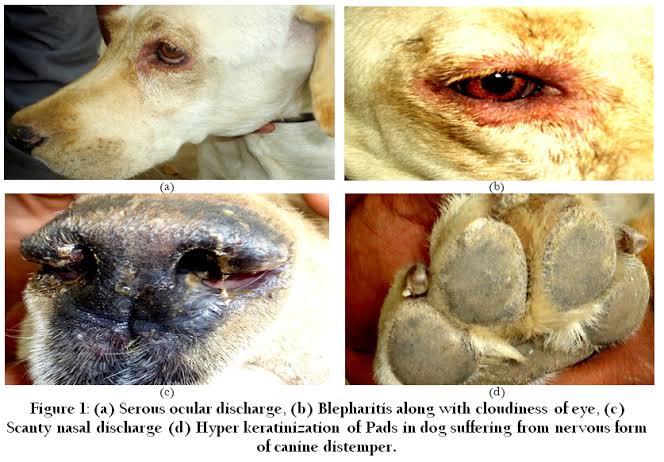
CANINE DISTEMPER
Canine distemper is an acute infectious viral disease characterized by fever, ocular and nasal catarrh and frequent cutaneous eruptions.
Etiology:
Canine distemper is caused by RNA virus belonging to paramyxo group.
Susceptible hosts:
All members of canine, Mustelidae, viveridae and Procyonidae. The disease is most important in dogs.
Canine distemper can be seen in all age groups. Incidence rate decreases with attainment of age.
Mode of transmission:
Canine distemper can be transmitted by,
Inhalation (droplet or aerosol)
Virus is discharged through secretions and excretions.
May indirectly be transmitted through ingestion of contaminated food and water.
Clinical findings:
- The animal is dull and depressed in initial phase
- High rise of temperature. Temperature reaction is characteristic and is known as diphasic. Temperature can go upto 103-to-104-degree F. In this stage they have dry and hot nose and congested eyes, they refuses to take food and seem depressed. In few days yellowish greenish discharge comes from eyes and nose. After 96 hours temperature usually comes down to normal. After about 11 to 12 days temperature rises again. In this stage they have rhinitis, conjunctivitis, gastroenteritis and bronchopneumonia according to involvement of system.
- Pulmonary form: oculonasal discharge, pharyngitis, bronchitis. Bronchopneumonia.
- Digestive form: loss of appetite, vomiting, abdominal pain. Stools- loose or semisolid, foul smelling. Stools may contain blood.
- Ocular form: swollen eyelids, conjunctivitis, purulent discharge from eyes. Pus can lead to ulceration in cornea.
- Nervous form: restlessness, excitement, chewing movements, excessive salivation and convulsion.
- Cutaneous form: rash, vesicles, pustules. Skin of foot pads and nose can become hard due to hyperkeratitis (hard pad disease). Vesicopustular eruptions can be seen in abdomen and inner parts of thighs of skin known as distemper exanthema.
Homoeopathic management of canine distemper:
Echinacea: foul smelling nasal discharge catarrh with ulcerations. Sore nostrils. Dull pain in both eyes. Offensive flatus or a yellowish stool, diarrhoea following pain in stomach. Little papules on skin with redness.
Bryonia: eyelids swollen and puffed. Diarrhoea gushing in the morning. Bronchitis. Difficult quick respiration.
Pulsatilla: thick, profuse, yellow, bland eye discharges. Itching and burning in eyes. Inflamed lids. Coryza, large green fetid scales in nose. Yellow mucus, bad smells. Stools watery, worse at night, dysentery with mucus and blood. Dry cough and night.
Verat alb: lachrymation with redness. Painful inflammation of eyes. Violent vomiting, with continued nausea, great exhaustion. Violent and painful diarrhoea. Watery diarrhoea.dry skin eruptions.
Dr. Keerthi MS
BHMS Consultant
Curewell Homoeo Pharmacy Pvt Ltd.
Aluva, Ernakulam, Kerala, India.
